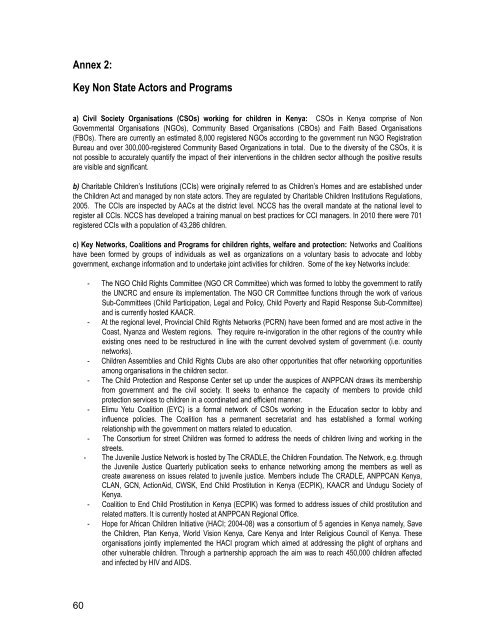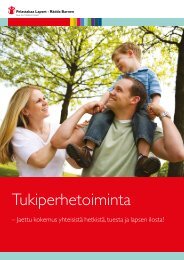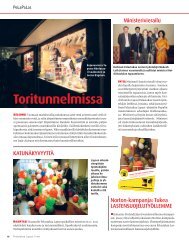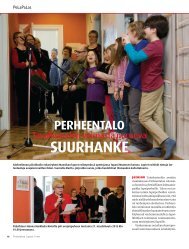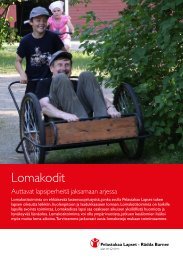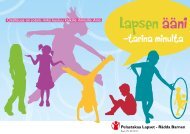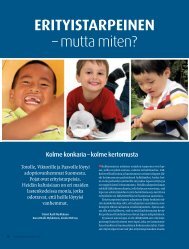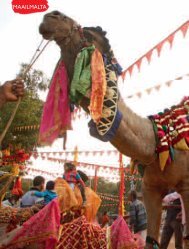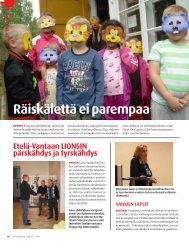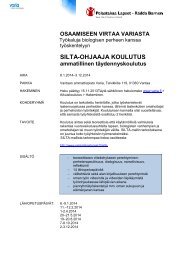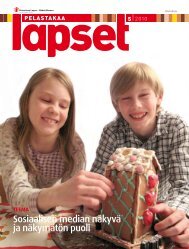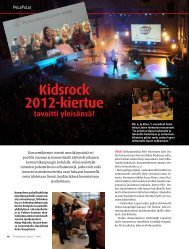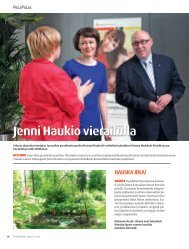Annex 2:Key Non State Actors and Programsa) Civil Society Organisations (CSOs) work<strong>in</strong>g for <strong>child</strong>ren <strong>in</strong> <strong>Kenya</strong>: CSOs <strong>in</strong> <strong>Kenya</strong> comprise of NonGovernmental Organisations (NGOs), Community Based Organisations (CBOs) and Faith Based Organisations(FBOs). There are currently an estimated 8,000 registered NGOs accord<strong>in</strong>g to the government run NGO RegistrationBureau and over 300,000-registered Community Based Organizations <strong>in</strong> total. Due to the diversity of the CSOs, it isnot possible to accurately quantify the impact of their <strong>in</strong>terventions <strong>in</strong> the <strong>child</strong>ren sector although the positive resultsare visible and significant.b) Charitable Children’s Institutions (CCIs) were orig<strong>in</strong>ally referred to as Children’s Homes and are established underthe Children Act and managed by non state actors. They are regulated by Charitable Children Institutions Regulations,2005. The CCIs are <strong>in</strong>spected by AACs at the district level. NCCS has the overall mandate at the national level toregister all CCIs. NCCS has developed a tra<strong>in</strong><strong>in</strong>g manual on best practices for CCI managers. In 2010 there were 701registered CCIs with a population of 43,286 <strong>child</strong>ren.c) Key Networks, Coalitions and Programs for <strong>child</strong>ren <strong>rights</strong>, welfare and protection: Networks and Coalitionshave been formed by groups of <strong>in</strong>dividuals as well as organizations on a volunta<strong>ry</strong> basis to advocate and lobbygovernment, exchange <strong>in</strong>formation and to undertake jo<strong>in</strong>t activities for <strong>child</strong>ren. Some of the key Networks <strong>in</strong>clude:- The NGO Child Rights Committee (NGO CR Committee) which was formed to lobby the government to ratifythe UNCRC and ensure its implementation. The NGO CR Committee functions through the work of variousSub-Committees (Child Participation, Legal and Policy, Child Poverty and Rapid Response Sub-Committee)and is currently hosted KAACR.- At the regional level, Prov<strong>in</strong>cial Child Rights Networks (PCRN) have been formed and are most active <strong>in</strong> theCoast, Nyanza and Western regions. They require re-<strong>in</strong>vigoration <strong>in</strong> the other regions of the count<strong>ry</strong> whileexist<strong>in</strong>g ones need to be restructured <strong>in</strong> l<strong>in</strong>e with the current devolved system of government (i.e. countynetworks).- Children Assemblies and Child Rights Clubs are also other opportunities that offer network<strong>in</strong>g opportunitiesamong organisations <strong>in</strong> the <strong>child</strong>ren sector.- The Child Protection and Response Center set up under the auspices of ANPPCAN draws its membershipfrom government and the civil society. It seeks to enhance the capacity of members to provide <strong>child</strong>protection services to <strong>child</strong>ren <strong>in</strong> a coord<strong>in</strong>ated and efficient manner.- Elimu Yetu Coalition (EYC) is a formal network of CSOs work<strong>in</strong>g <strong>in</strong> the Education sector to lobby and<strong>in</strong>fluence policies. The Coalition has a permanent secretariat and has established a formal work<strong>in</strong>grelationship with the government on matters related to education.- The Consortium for street Children was formed to address the needs of <strong>child</strong>ren liv<strong>in</strong>g and work<strong>in</strong>g <strong>in</strong> thestreets.- The Juvenile Justice Network is hosted by The CRADLE, the Children Foundation. The Network, e.g. throughthe Juvenile Justice Quarterly publication seeks to enhance network<strong>in</strong>g among the members as well ascreate awareness on issues related to juvenile justice. Members <strong>in</strong>clude The CRADLE, ANPPCAN <strong>Kenya</strong>,CLAN, GCN, ActionAid, CWSK, End Child Prostitution <strong>in</strong> <strong>Kenya</strong> (ECPIK), KAACR and Undugu Society of<strong>Kenya</strong>.- Coalition to End Child Prostitution <strong>in</strong> <strong>Kenya</strong> (ECPIK) was formed to address issues of <strong>child</strong> prostitution andrelated matters. It is currently hosted at ANPPCAN Regional Office.- Hope for African Children Initiative (HACI; 2004-08) was a consortium of 5 agencies <strong>in</strong> <strong>Kenya</strong> namely, Savethe Children, Plan <strong>Kenya</strong>, World Vision <strong>Kenya</strong>, Care <strong>Kenya</strong> and Inter Religious Council of <strong>Kenya</strong>. Theseorganisations jo<strong>in</strong>tly implemented the HACI program which aimed at address<strong>in</strong>g the plight of orphans andother vulnerable <strong>child</strong>ren. Through a partnership approach the aim was to reach 450,000 <strong>child</strong>ren affectedand <strong>in</strong>fected by HIV and AIDS.60
- The National Children <strong>in</strong> Need Network was a coalition formed to address <strong>child</strong> <strong>rights</strong> and <strong>child</strong> protectionafter the Hear<strong>in</strong>g on Street Children organized by ANPPCAN <strong>in</strong> 1994 to discuss the plight of street <strong>child</strong>ren.- Programs for street <strong>child</strong>ren: CSOs have had programmes target<strong>in</strong>g <strong>child</strong>ren liv<strong>in</strong>g and work<strong>in</strong>g on thestreets with various <strong>in</strong>terventions over the years. The programmes are spread throughout the count<strong>ry</strong> and<strong>in</strong>clude Undugu Society of <strong>Kenya</strong>, Salvation Army and Nyalenda Catholic Church (supportive programmes);CWSK, Child Fund, ActionAid <strong>Kenya</strong> (AAK), Starehe Boys Centre and School, Salesians of Don Bosco,Disciples of Mercy, SOS Children's Home, SNV and Barnardo's Children's Home.- The Diversion Program seeks to improve the Juvenile Justice System <strong>in</strong> <strong>Kenya</strong>. Save the Children Sweden<strong>in</strong> collaboration with the Department of Children Services, the Police and other key partners from thegovernment and the NGO sector developed a diversion framework <strong>in</strong> 2001. The target was <strong>child</strong>ren <strong>in</strong> thecrim<strong>in</strong>al justice system who would be identified and diverted at the earliest po<strong>in</strong>t of contact with the justicesystem, which <strong>in</strong> most cases is the police station. In the long term this would result <strong>in</strong> the improvement of thejuvenile justice system <strong>in</strong> the count<strong>ry</strong> as communities would have the capacity to deal with juvenile justicerelated issues <strong>in</strong> their own way. Diversion projects have been implemented <strong>in</strong> Kilimani, Kamukunji, BuruBuru, Kasarani (all <strong>in</strong> Nairobi), Naivasha, Nakuru, Bondeni, Kitale, Gucha, Kisii, Siaya, Kisumu, Busia andKakamega Police Stations.Programmes and Initiatives to Address Child LabourPoverty and the stagnation of the economy <strong>in</strong> <strong>Kenya</strong> have led to ris<strong>in</strong>g <strong>in</strong>cidences of <strong>child</strong> abuse, <strong>in</strong>clud<strong>in</strong>g <strong>child</strong> labour.To address this, a National Action Plan (NAP) has been developed to address <strong>child</strong> labour. It is formulated andimplemented as an <strong>in</strong>tegral part of the National Poverty Reduction Strategy Programme (PRSP) and Vision 2030. TheNAP design is also underp<strong>in</strong>ned and guided by the government’s commitment to key national and <strong>in</strong>ternational legaland policy <strong>in</strong>struments, among them the UNCRC, ACRWC, ILO Conventions 138, 182, 29, 105, 81 as well as theMillennium Development Goals (MDGs) and Education for All (EFA) <strong>in</strong>itiatives. The NAP also takes <strong>in</strong>to considerationthe new Constitution which prohibits all forms of exploitative labour. It is based on a comprehensive and multi-sectoralapproach requir<strong>in</strong>g the commitment of all stakeholders <strong>in</strong>clud<strong>in</strong>g government, trade unions, employer organisations,the civil society, private sector, development partners, parents, guardians and beneficiaries. Membership <strong>in</strong>cludes GoK<strong>in</strong>clud<strong>in</strong>g the M<strong>in</strong>ist<strong>ry</strong> of Labour, the media, NGOs and religious organizations. ANPPCAN Regional Office serves asthe secretariat.Interventions to address <strong>child</strong> labour <strong>in</strong> <strong>Kenya</strong> undertaken by both the government and members of the civil society<strong>in</strong>clude the follow<strong>in</strong>g:a) Development of a comprehensive legal framework <strong>in</strong>clud<strong>in</strong>g the Children Act, 2001.b) Review of the exist<strong>in</strong>g laws <strong>in</strong>clud<strong>in</strong>g Labour Laws and the Children Act.c) Domestication of relevant <strong>in</strong>ternational and regional treaties.d) A partnership programme between GoK and ILO/IPEC. This <strong>in</strong>cludes the Time BoundProgramme.e) Trade unions and the Federation of <strong>Kenya</strong> Employers (FKE) have been sensitized on <strong>child</strong> labour.f) Communities have been encouraged to start <strong>in</strong>come-generat<strong>in</strong>g activities <strong>in</strong> schools with a viewto encourag<strong>in</strong>g <strong>child</strong>ren to stay <strong>in</strong> school.g) Labour <strong>in</strong>spectors have been tra<strong>in</strong>ed to monitor <strong>child</strong> labour activities <strong>in</strong> the count<strong>ry</strong>.h) A UN Jo<strong>in</strong>t Programme on Youth Employment and Empowerment has been started.i) ANPPCAN Regional Office ran a <strong>child</strong> labour programme which provided appropriate development models forcombat<strong>in</strong>g <strong>child</strong> labour <strong>in</strong> <strong>Kenya</strong> and by the end of 2006, over 10,000 <strong>child</strong>ren had benefited from programme<strong>in</strong>terventions s<strong>in</strong>ce 1997. The programme operated <strong>in</strong> fourteen districts and focused on <strong>child</strong>ren at risk of dropp<strong>in</strong>g outof school to jo<strong>in</strong> the worst forms of <strong>child</strong> labour as well as provid<strong>in</strong>g alternatives to those withdrawn from <strong>child</strong> labour.j) Child Welfare Society of <strong>Kenya</strong> (CWSK) has through the Rescue Peace House Centre rescued girls from the streetsand counselled, rehabilitated, resettled and placed them <strong>in</strong> vocational tra<strong>in</strong><strong>in</strong>g centres and <strong>in</strong>formal schools.k) The <strong>Kenya</strong> Institute of Education has <strong>in</strong>corporated <strong>child</strong> labour messages <strong>in</strong> the exist<strong>in</strong>g school curriculum.l) Legal aid organisations such as FIDA <strong>Kenya</strong>, CLAN and The CRADLE have handled cases of physically or sexuallyabused <strong>child</strong>ren referred to them by organisations work<strong>in</strong>g <strong>in</strong> the <strong>child</strong> labour sector such as SINAGA.m) UNICEF works closely with the World Bank and ILO <strong>in</strong> the project ‘Understand<strong>in</strong>g Children’s Work’. This <strong>in</strong>teragencyprogramme aims to address the crucial need for more and better data on <strong>child</strong> labour.61


